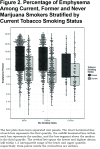Marijuana Use Associations with Pulmonary Symptoms and Function in Tobacco Smokers Enrolled in the Subpopulations and Intermediate Outcome Measures in COPD Study (SPIROMICS)
- PMID: 29629404
- PMCID: PMC5870739
- DOI: 10.15326/jcopdf.5.1.2017.0141
Marijuana Use Associations with Pulmonary Symptoms and Function in Tobacco Smokers Enrolled in the Subpopulations and Intermediate Outcome Measures in COPD Study (SPIROMICS)
Abstract
Background: Marijuana is often smoked via a filterless cigarette and contains similar chemical makeup as smoked tobacco. There are few publications describing usage patterns and respiratory risks in older adults or in those with chronic obstructive pulmonary disease (COPD). Methods: A cross-sectional analysis of current and former tobacco smokers from the Subpopulations and Intermediate Outcome Measures in COPD Study (SPIROMICS) study assessed associations between marijuana use and pulmonary outcomes. Marijuana use was defined as never, former (use over 30 days ago), or current (use within 30 days). Respiratory health was assessed using quantitative high-resolution computed tomography (HRCT) scans, pulmonary function tests and questionnaire responses about respiratory symptoms. Results: Of the total 2304 participants, 1130 (49%) never, 982 (43%) former, and 192 (8%) current marijuana users were included. Neither current nor former marijuana use was associated with increased odds of wheeze (odds ratio [OR] 0.87, OR 0.97), cough (OR 1.22; OR 0.93) or chronic bronchitis (OR 0.87; OR 1.00) when compared to never users. Current and former marijuana users had lower quantitative emphysema (P=0.004, P=0.03), higher percent predicted forced expiratory volume in 1 second (FEV1%) (P<0.001, P<0.001), and percent predicted forced vital capacity (FVC%) (p<0.001, P<0.001). Current marijuana users exhibited higher total tissue volume (P=0.003) while former users had higher air trapping (P<0.001) when compared to never marijuana users. Conclusions: Marijuana use was found to have little to no association with poor pulmonary health in older current and former tobacco smokers after adjusting for covariates. Higher forced expiratory volume in 1 second (FEV1) and forced vital capacity (FVC) was observed among current marijuana users. However, higher joint years was associated with more chronic bronchitis symptoms (e.g., wheeze), and this study cannot determine if long-term heavy marijuana smoking in the absence of tobacco smoking is associated with lung symptoms, airflow obstruction, or emphysema, particularly in those who have never smoked tobacco cigarettes.
Keywords: Lung; chronic obstructive pulmonary disease; computed tomography scan; cross-sectional; emphysema; epidemiology; forced expiratory volume; forced vital capacity; marijuana; pulmonary; respiratory; smoking; tobacco.
Conflict of interest statement
Declaration of Interest The authors report no conflicts of interest. The authors alone are responsible for the content and writing of the paper.
References
-
- Maertens RM,White PA,Williams A,Yauk CL. A global toxicogenomic analysis investigating the mechanistic differences between tobacco and marijuana smoke condensates in vitro. Toxicology. 2013;308:60-73. doi: https://doi.org/10.1016/j.tox.2013.03.008 - PubMed
-
- WU T-C,Tashkin DP,Djahed B,Rose JE. Pulmonary hazards of smoking marijuana as compared with tobacco. N Engl J Med. 1988;318(6):347-351. doi: https://doi.org/10.1056/NEJM198802113180603 - PubMed
-
- Tashkin DP,Baldwin GC,Sarafian T,Dubinett S,Roth MD. Respiratory and immunologic consequences of marijuana smoking. J Clin Pharmacol. 2002;42(11Suppl):71S-81S. doi: https://doi.org/10.1002/j.1552-4604.2002.tb06006.x - PubMed
-
- Tashkin DP,Shapiro BJ,Frank IM. Acute effects of smoked marijuana and oral delta9-tetrahydrocannabinol on specific airway conductance in asthmatic subjects. Am Rev Respir Dis. 1974;109(4):420-428. - PubMed
-
- Tashkin DP. Airway effects of marijuana, cocaine, and other inhaled illicit agents. Curr Opin Pulm Med. 2001;7(2):43-61. doi: https://doi.org/10.1097/00063198-200103000-00001 - PubMed
Grants and funding
- HHSN268200900009C/WH/WHI NIH HHS/United States
- P30 ES005605/ES/NIEHS NIH HHS/United States
- R01 HL095432/HL/NHLBI NIH HHS/United States
- R01 HL089856/HL/NHLBI NIH HHS/United States
- HHSN268200900015C/HL/NHLBI NIH HHS/United States
- HHSN268200900016C/HL/NHLBI NIH HHS/United States
- U01 HL137880/HL/NHLBI NIH HHS/United States
- HHSN268200900018C/HL/NHLBI NIH HHS/United States
- HHSN268200900013C/HL/NHLBI NIH HHS/United States
- K23 HL130627/HL/NHLBI NIH HHS/United States
- HHSN268200900014C/HL/NHLBI NIH HHS/United States
- R01 HL089897/HL/NHLBI NIH HHS/United States
- HHSN268200900019C/HL/NHLBI NIH HHS/United States
- HHSN268200900017C/HL/NHLBI NIH HHS/United States
- HHSN268200900020C/HL/NHLBI NIH HHS/United States
LinkOut - more resources
Full Text Sources
Other Literature Sources
Medical
Molecular Biology Databases



